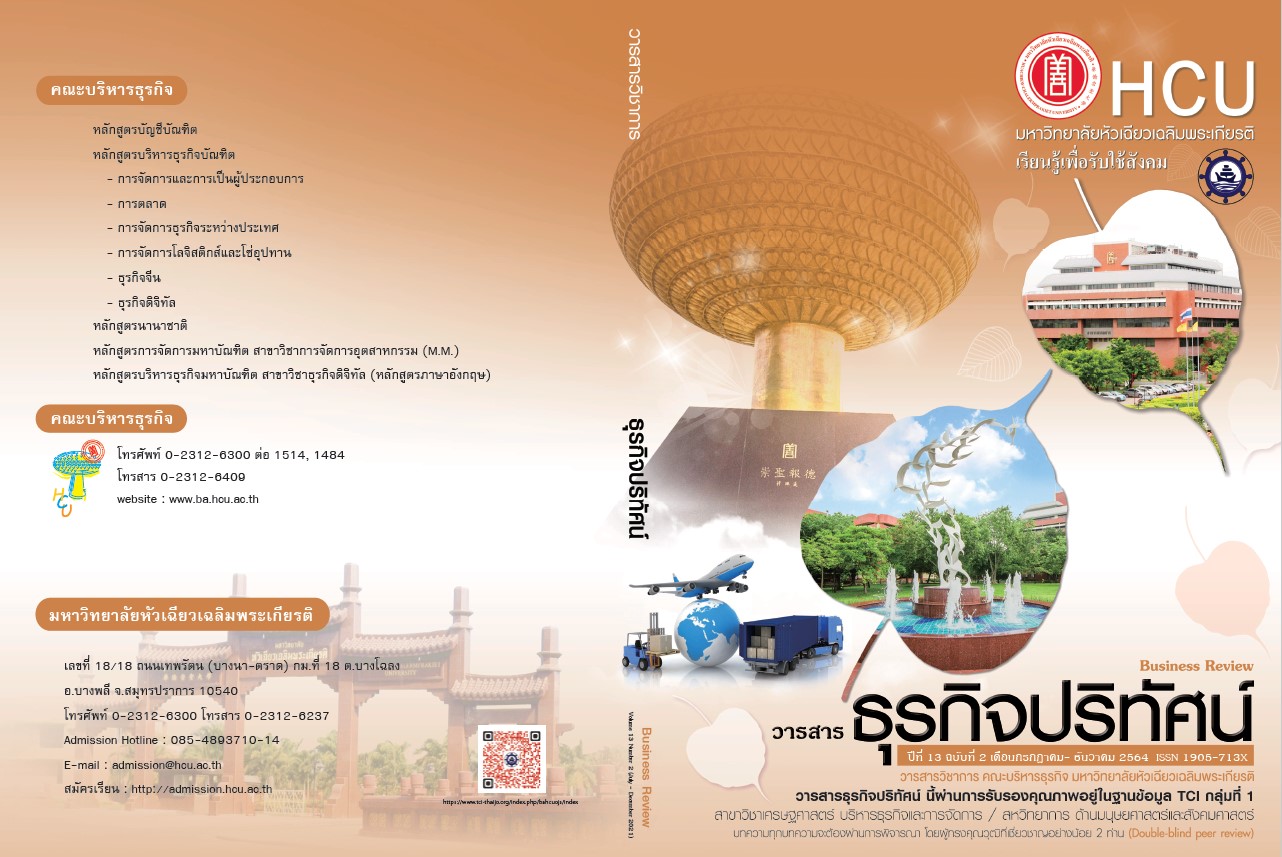การวิเคราะห์เส้นทางการตัดสินใจกลับมาใช้บริการซ้ำของผู้ใช้บริการนวดไทย
Keywords:
Decision Making, Experience Marketing, Repurchases, Thai MassageAbstract
This research aimed to study the decision-making path analysis and factors influence the users’ repurchase of Thai massage. The research conducted a study to gathered data from 2,500 users who have an experience more than 1 years and 2,500 users who have an experience less than 1 year from 5 provinces in the tourism area that consisted of Bangkok, Chon Buri, Phuket, Chiang Mai, and Udon Thani, by studied the experiences of customers using Thai massage and repurchase trends.
In this regard, researchers analyzed the influence of the customer experience variables in each dimension on repurchase trends by multiple regression analysis. The result indicated that customer experience influenced repurchase trends. The most influential factor was the product or service experience, followed by the peace-of-mind, outcome focus, and moment-of-truth. The analysis of the decision-making Path indicated that the first factor was the product or service experience. The next issue was the outcome focus and moment-of-truth. Which requires a high level of experience to be able to use the service again
References
กรมสนับสนุนบริการสุขภาพ. (2560). คู่มือธุรกิจสปา. นนทบุรี: กรมสนับสนุนบริการสุขภาพ กระทรวง สาธารณสุข.
กัลยา วาณิชย์บัญชา และฐิตา วาณิชย์บัญชา. (2561). การใช้ SPSS for Windows ในการวิเคราะห์ข้อมูล. กรุงเทพฯ: สำนักพิมพ์แห่งจุฬาลงกรณ์มหาวิทยาลัย.
พสุนิต สารมาศ, นราภรณ์ ขันธบุตร, และอุบลวรรณ อยู่สุข. (2551). ศึกษาหมอนวดแผนไทย: ผู้ให้บริการ ส่งเสริมสุขภาพในจังหวัดเชียงใหม่. เชียงใหม่: มหาวิทยาลัยแม่โจ้.
สถาบันการแพทย์แผนไทย. (2547). คู่มือประชาชนในการดูแลสุขภาพด้วยการแพทย์แผนไทย. กรุงเทพฯ: กลุ่ม งานพัฒนาวิชาการแพทย์แผนไทยและสมุนไพร สถาบันการแพทย์แผนไทย.
สถาบันการแพทย์แผนไทย. (2558). คู่มือมาตรฐาน การนวดไทยในสถานพยาบาลภาครัฐ/เอกชน และสถาน บริการ/สถานประกอบการ ปี 2558. กรุงเทพฯ: กลุ่มงานการนวดไทย สถาบันการแพทย์แผนไทย กรม พัฒนาการแพทย์แผนไทยและการแพทย์ทางเลือก.
อภิรดี ธรรมสรณ์. (2560). การศึกษาผลของการนวดแผนไทยต่อคุณภาพชีวิต ด้านสุขภาพของกลุ่มคนวัยทำงาน. สารนิพนธ์วิทยาศาสตร์มหาบัณฑิต, มหาวิทยาลัยธุรกิจบัณฑิตย์.
Buttle, F., & Burton, J. (2002). Does service failure influence customer loyalty?. Journal of Consumer Behaviour, 1 (3), 217-227.
Edvardsson, B., Gustafsson, A., & Roos, I. (2005). Service portraits in service research – a critical review. International Journal of Service Industry Managemen, 16 (1), 107-121.
Erna, A. (2015). Understanding Customer Experience Management in Retailing. Procedia-Social and Behavioral Sciences, 211 (25), 629-633.
Gentile, C., Spiller, N., & Noci, G. (2007). How to sustain the customer experience: An overview of experience components that co-create value with the customer. European Management Journal, 25, 395-410.
Global Wellness Institute. (2018). Global Wellness Economy Monitor. Florida: Global Wellness Institute.
Imran, K., Ruchi, J. G., & Zillur, R. (2015). Customer service experience in hotel operation: An empirical analysis. Procedia Social and Behavioral Sciences, 189, 266–274.
Kashif, M., Samsi, S. Z. M., Awang, A., & Mohamad, M. (2016). Healthcare service quality effect on patient satisfaction and behavioural intentions in corporate hospitals in India. International Journal of Pharmaceutical and Healthcare Marketing, 10 (1), 48-74.
Klaus, P., & Maklan, S. (2011). Towards a better measure of customer experience. International Journal of Market Research, 55 (2), 771-792.
Klaus, P., & Maklan, S. (2012). EXQ: A Multiple Scale for Assessing Service Experience. Journal of Service Management, 23 (1), 5–33.
Klaus, P., & Maklan, S. (2013). Towards a Better Measure of Customer Experience. International Journal of Market Research, 55 (2), 227-246.
Kotu, B., & Deshpande, V. (2014). Predictive Analytics and Data Mining: Concepts and Practice with RapidMiner. Massachusetts: Morgan Kaufmann.
Lee, Y., Lin, Y., Huang, C., & Fredrickson, B. L. (2013). The Construct and Measurement of Peace of Mind. J Happiness Stud, 14, 571–590.
Raisa, N. M., Musa, R., & Muda, M. (2016). Reconceptualisation of Customer Experience Quality (CXQ) Measurement Scale. Procedia Economics and Finance, 37, 299 – 303.
Roy, R., Chintagunta, P., & Haldar, S. (1996). A framework for investigating habits, ‘The Hand of the Past,’ and heterogeneity in dynamic brand choice. Marketing Science, 15 (3), 280–299.
Saunders, M., Lewis, Philip, L., & Thornhill, A. (2015). Research Methods for Business Students. Fifth edition. England: Prentice Hall.
Schmitt, B.H. (1999). Experiential Marketing: How to Get Customers to Sense, Feel, Think, Act, and Relate to Your Company and Brands. New York: Free Press.
Tax, S. S., & Brown, S. W. (1998). Recovering and learning from service failure. Sloan Management Review, 40 (1), 75-88.
Voss, C., & Zomerdijk, L. (2015). Innovation in Experiential Services – An Empirical View Innovation in Experiential Services – An Empirical View. London: London Business School
Wagner, W. E. (2019). Using IBM SPSS Statistics for Research Methods and Social Science Statistics. Seventh edition. California: Sage Publishing.
Zolkiewski, J., Story, V.M., Burton, J., Chan, P., Gomes, A., Hunter-Jones, P., O'Malley, L., Peters, L., Raddats, C., & Robinson, W. (2017). Strategic B2B Customer Experience Management: The Importance of Outcomes-Based Measures. Journal of Services Marketing, 31 (2), 172-184.
Downloads
Published
How to Cite
Issue
Section
License
All articles published in the Business Administration and Management Journal Review are copyrighted by the journal.
The views and opinions expressed in each article are solely those of the individual authors and do not represent those of Huachiew Chalermprakiet University or any other faculty members. Each author is fully responsible for the content of their own article. Any errors or issues found are the sole responsibility of the respective author.




